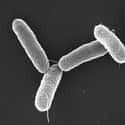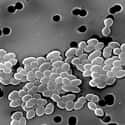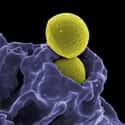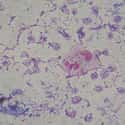-
(#11) Drug-Resistant Salmonella Serotype Typhi
Symptoms: Fever, abdominal pain, headache, bowl perforation, shock
Fatal: Yes
Treatment Options: Vaccination (preventative), antibiotics
CDC Hazard Level: Serious
Another serotype of salmonella, this is the strain that causes typhoid fever. People in the developing world and those who travel there are at a higher risk of contracting typhoid fever, which can be fatal in some cases. Over 20 million people are infected with typhoid fever each year, making it an extremely important disease to study. Drug-resistance has been identified in multiple serotypes of salmonella, including the typhoid-inducing strains.
-
(#2) Carbapenem-Resistant Enterobacteriaceae
Symptoms: Fever, generally feeling unwell, rapid pulse, pain in heart
Fatal: Yes
Treatment Options: Draining, certain antibiotics
CDC Hazard Level: Urgent
Carbapenem-resistant Enterobacteriaceae (CRE) is the name given to a family of different germs that have proven difficult to treat with antibiotics, including diseases like E. coli. According the CDC, CRE bacteria have become nearly impossible to treat with most existing drugs. This is a major problem, as reports state that up to 50% of infections result in death. CRE can also exist inside a host body with no signs of infection, making it easier for the bacteria to spread. Generally, CRE is spread via person to person contact and most people become infected in hospital settings and generally overseas.
Some clinicians have reported the existence of strains that are resistant to all antibiotics, a chilling fact that has driven the CDC to label CRE as an urgent threat.
-
(#8) Vancomycin-Resistant Enterococcus
Symptoms: Colonization, infections of the urinary tract and bloodstream
Fatal: Yes
Treatment Options: Antibiotics other than vancomycin
CDC Hazard Level: Serious
As their name would suggest, VREs are strains of Enterococcus that have developed an immunity to the antibiotic vancomycin. Enterococci live in both the digestive system and the genital tract, and we all have them. Most of the time they are completely harmless, but they do have the ability to become infectious. When that happens, they can usually be treated with vancomycin. VREs are a different case, and must be combated with alternative antibiotics and can be more difficult to treat. While VRE infections can be fatal, less than 10% of infected patients in the United States die from them. People who've recently undergone surgery, have a weakened immune system, or use medical devices that stay in the body (like urinary or IV catheters) are more likely to become infected.
-
(#13) Staphylococcus aureus
Symptoms: Sepsis, pneumonia, bloodstream infection
Fatal: Yes
Treatment Options: Drainage, vancomycin, other functional antibiotics
CDC Hazard Level: Serious
Staphylococcus aureus is an incredibly common bacteria that has colonies in roughly 30% of the human population. The bacteria can cause a wide variety of symptoms and can be fatal if left untreated. Methicillin-Resistant Staphylococcus aureus (MRSA) is an extremely deadly strain that is antibiotic-resistant and killed more than 11,000 people in the United States annually. MRSA is becoming more common, leading the CDC to deem the disease a serious threat.
-
(#9) Pseudomonas infection
Symptoms: Ear infections, rashes, pneumonia, sepsis
Fatal: Yes
Treatment Options: Case-specific antibiotics
CDC Hazard Level: Serious
Pseudomonas aeruginosa is the most common infection causing bacteria in the Pseudomonas genera. Each year, over 50,000 people become infected. Like many bacterial infections, Pseudomonas infections that originate in hospitals are becoming more difficult to treat. In cases of Multidrug-Resistant P. aeruginosa, each individual case must be lab tested in order to determine a viable antibiotic treatment. It is believed that up to 13% of all P. aeruginosa infections are now multidrug-resistant.
-
(#3) Gonorrhea
- Pelvic pain, Swollen testicle, Dysuria, Vaginal bleeding, Abdominal pain, Abnormal vaginal discharge, Penile discharge
Symptoms: Usually no symptoms, but can cause painful urination, vaginal bleeding, discharge from penis/vagina, swollen testicles, itching, soreness
Fatal: No
Treatment Options: Antibiotics
CDC Hazard Level: Urgent
Gonorrhea is an infamous STD that can be passed by vaginal, oral, and anal sex. It's an extremely common disease, the second most reported STD with 350,062 infections in 2014 alone. The disease can be extremely painful, although some people may get it and never show any outward symptoms. Women are especially unlikely to show symptoms. While it is traditionally treated with antibiotics, studies have shown that gonorrhea has become more resistant to these drugs over the years. Over 15% of tested bacterium showed a resistance to penicillin, once one of the most common and effective antibiotics. The resistance rate for other, less common antibiotics was even higher.
Long term infection can do serious damage, including making women infertile. Certain antibiotics can still be used to cure many strains, but more research is required to make sure this once curable disease remains that way.
New Random Displays Display All By Ranking
About This Tool
Whether in medicine or agriculture, the abuse or overuse of antibiotics can lead to the emergence of multiple drug-resistant bacteria. Experts in the prevention and control of infectious diseases also pointed out that infectious diseases like Ebola cannot be eradicated because the virus still exists in animals. Drug resistance may occur with drug treatment. Drug-resistant diseases are the most dangerous, and vaccines must be used to eradicate infectious diseases.
For example, due to the overuse of drugs, the older generation of antibiotics has been unable to cure new potentially fatal infections. The random tool lists the 15 most dangerous drug-resistant diseases in the world.
Our data comes from Ranker, If you want to participate in the ranking of items displayed on this page, please click here.















